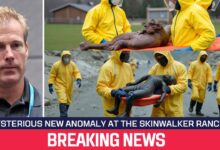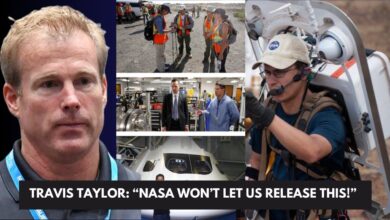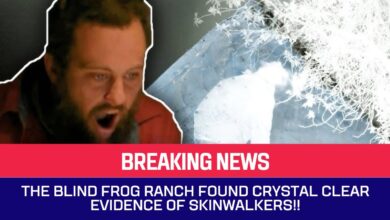INEXPLICABLE FIND Inside the Mesa | The Secret of Skinwalker Ranch (Season 3)
INEXPLICABLE FIND Inside the Mesa | The Secret of Skinwalker Ranch (Season 3)

Well, you guys ready to go at it again?
Yeah, we’re ready.
Aaron, you’re gonna want to see this.
This is what came out of your tank. This material here, it’s rather brittle.
Out of the spoils that we went and dumped over there, this came out of the pit.
Yeah, yeah. Any chances it’s coming off of your equipment?
There’s no way it would come out of the drill.
Well, I say we get at it and see if we can get you past that point.
Yeah, let’s see if we can break through there.
How far back are we?
We are about 311 feet.
Okay, and you’re still hitting up against that?
Yeah, still hitting up against it.
Okay.
Boy, that thing sounds like it’s hitting something.
Oh, what the heck is—
Hey guys, come on down here.
So we’re coming up about 11 inches every 10 feet.
So it was directing you downward, and now you’re still on it, but it’s allowing you to go upwards.
Right, so that tells us something about the shape of this hard layer or this, whatever this impenetrable thing is.
So it sounds like you’re describing kind of a V.
It may not even be a V, it could even be maybe a dome.
Oh, really? Because you’re not that sharp of a turn.
I’m gonna be really fascinated to see what’s coming out of that hole.
So when you guys get ready to dump the spoils, we definitely want to put a screen under there and catch it.
We definitely want to analyze that.
There we go.
More metal.
Check this out.
Wow, look at all the metal.
Yeah, there’s one right there, and some of it’s fairly…
Look how much of this stuff is in this little spoils pile.
Right, so there’s no telling how much of this metallic crap there is still in that hillside.
The fact that we’re getting all these thin layers of this substance and Aaron was hitting something so hard with his drill rig he couldn’t penetrate it…
Are we just chipping away at something much larger under the mesa?
I don’t know, but we have to find out.
We were all eager to see just what the huge dome-shaped object buried inside the mesa could be, so we brought out underground visualization expert Ryan Markintel to feed a specialized robotic camera into the hole we drilled.
Oh, wow.
So this goes right under the mesa, 400 feet that way.
Let’s get the equipment. We can set it up. Hopefully, you can just climb down, stand in that, feed it in—easy.
The robotics that we use are really designed for confined spaces, great for purposes like this.
So we brought out a VT-100, which is a robot with a PTZ camera on it, 1080p readout. It can be configured in many different forms. Today, we’re using tracks just because we’re navigating over different types of terrain.
Everything seems to be working fine.
What we’ll do is, we’ll go ahead and I’ll get down there now, and I’ll go ahead and put it in the hole.
Okay, and then we’ll go ahead and start, and we’ll keep a visual on everything.
All right, so we will start recording right now.
Let me at least get some here so it doesn’t have to work so hard.
Hey, Thomas, if you wouldn’t mind, I’m gonna go forward, just feed it into the hole as I’m going forward.
Okay, go ahead.
Tracks are moving fine, Thomas.
Oh yeah.
Oh, there we go.
So we bring in this camera that sits on crawlers, and it’s designed to crawl up and it can go up as far as a thousand feet.
How far down is that?
We were a little over 10 feet a while ago.
I’m actually looking right now at what looks like a great big boulder that looks like it may have actually fallen right over that opening.
You see what I’m talking about right there?
Yeah, that’s a big rock.
That is a big rock.
What are the odds of one, which almost looks like a perfectly round boulder, going and covering up that opening?
Gosh, this ranch—
It’s odd how you say it’s very cylindrical. That’s so odd.
It is, just like it’s been plugged. It almost looks like it was just a plug that was stuck in place there.
Hey, Dragon Tom, you guys copy? You want to get it?
Yeah, Travis, go ahead.
Have you all found anything up there yet?
We just found a great big boulder, almost perfectly round, that fell down and blocked the entrance.
Now, that’s a little bit crazy and suspicious.
Just what the hell could be in this mesa, and what is preventing us from finding out?
We’ll get it, it’s just…
By these means, it’s not gonna happen today.
Let’s get this stuff cleaned up and get out of here.
Thanks, Ryan.
Oh, thank you. I appreciate you guys.
[Music]
Hey, gentlemen.
Hey guys, we’ve got the analysis back from the lab that did the scanning electron microscope elemental analysis of that material you guys pulled out of the drill hole.
Really?
Yeah, the next day, Eric received a report from the materials science and engineering department at the University of Utah about the metal the guys drilled out of the mesa.
So we all gathered in the command center to review it and see what this huge dome-shaped object might be made of.
The data that they gave us from the elemental analysis, it’s really interesting.
On one side of the material, there’s tellurium, and on the other side of the material, there’s europium.
Tellurium is a semiconductor material that is used in solar panels. The europium…
It’s been experimentally measured that under certain circumstances, it’s a superconductor.
Really?
Yeah, the elements found in this metal from deep inside the mesa have properties just like those of a semiconductor and a superconductor, which are both used in modern-day electronics like computer processors, MRI machines, electric vehicles, radios, and even smartphones.
But why is it here on Skinwalker Ranch?
And what’s interesting is, tellurium is the second most rare element on the planet.
Same goes for europium; it is actually one of the most rare elements on the planet also.
That’s interesting.
Wow, those things have specific uses.
Both of those materials are used in developing modern quantum computer systems.
So it sounds like we’re looking at a structured material, like as if it were perhaps deliberately structured—at least that’s what I’m reading into what you’re saying.
Well, how else do you get one of the elements only on one side and one of the elements only on the other side?
Well, that’s a lot of information to digest.
You know, what are we hitting—something that we’re not supposed to be finding? Is there more at play here than that?
Is it… gosh, if we want to go crazy, some sort of a craft or something like that that was put in there, that we’re finally hitting into, that was never supposed to be discovered? I don’t know.
Let’s not forget now, we have been told many, many stories about these deep caverns, the hill opening up, and the ship flying in. So there’s so many questions.
Why only one element on one side, why one on the other? Why is it so wafer-thin? Why the hell is it in our mesa?
There are so many questions that open up.
Well, looking at what we’ve got in our hands, I want to take these samples to a metallurgist.
I am hopeful that we might be able to take samples like this and put them in front of someone who does this work and ask, “Have you seen this stuff?”
Good idea. Let’s do that.
Okay, all right, let’s do it.
Good morning.
Good morning.
Hey Travis, Taylor, Robbie, Adrian, nice to meet you, sir.
Eric Bard, nice to meet you.
So you did the analysis of the samples that we sent?
Yes, we did. The samples that we looked at are composed of different elements like iron, calcium, and plus oxygen.
Okay, the samples look like they’ve been fused.
Now, that’s interesting.
What among the rarer elements did you see in the sample?
I’m surprised to see magnesium.
There is some evidence for manganese, aluminum, and so on.
The way I understand it, there’s also trace elements of europium and tellurium in the sample?
Yes, there is some presence of these rare elements.
Okay, they could be manufactured.
This material was manufactured as opposed to a natural occurrence?
Yes.
Materials like these are analogous to ceramic oxides. They’re using special tiling to protect from burning up due to reentry.
That’s interesting.
That’s actually very interesting.
If this huge dome-shaped object in the mesa is covered with the same kind of materials that NASA uses to protect space shuttles from burning up when they re-enter our atmosphere, could the rumors we’ve heard about a spacecraft being buried on Skinwalker Ranch really be true?
Well, I hope that we can find more samples in the not-too-distant future and get back out here with more, and maybe get some more details and more data that may help us get to that answer.
Sure, we’ll be happy to help.
Well, this has been real fantastic. Thank you very much.
Good luck with your endeavors.
Thank you.
Thank you.








